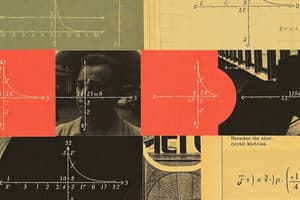Podcast
Questions and Answers
What is a linear equation?
What is a linear equation?
Any equation that can be written in the form of ax + by = c, where a, b, and c are constants.
What is a system of linear equations?
What is a system of linear equations?
A collection of one or more linear equations involving the same variables.
What is a solution of a linear equation?
What is a solution of a linear equation?
A list of numbers that satisfies a system of linear equations.
What is a solution set?
What is a solution set?
What makes two linear systems equivalent?
What makes two linear systems equivalent?
What is a consistent linear system?
What is a consistent linear system?
What is an inconsistent linear system?
What is an inconsistent linear system?
What is a matrix?
What is a matrix?
What is the size of a matrix?
What is the size of a matrix?
What are the elementary row operations?
What are the elementary row operations?
Define row equivalent.
Define row equivalent.
What are two fundamental questions about a system of linear equations?
What are two fundamental questions about a system of linear equations?
What is a nonzero column or row in a matrix?
What is a nonzero column or row in a matrix?
What is a leading entry in a matrix?
What is a leading entry in a matrix?
What are the criteria for a matrix to be in echelon form?
What are the criteria for a matrix to be in echelon form?
What are the criteria for a matrix to be in reduced echelon form?
What are the criteria for a matrix to be in reduced echelon form?
True or false: when a matrix is row reduced into another matrix, U, in echelon form, there is only one such U.
True or false: when a matrix is row reduced into another matrix, U, in echelon form, there is only one such U.
True or false: when a matrix is row reduced into another matrix, U, in reduced row echelon form, there is only one such U.
True or false: when a matrix is row reduced into another matrix, U, in reduced row echelon form, there is only one such U.
Define pivot position and pivot column.
Define pivot position and pivot column.
Explain the Row reduction algorithm.
Explain the Row reduction algorithm.
Define basic variables and free variables.
Define basic variables and free variables.
What is the Existence and uniqueness theorem?
What is the Existence and uniqueness theorem?
How to use row reduction to solve a linear system?
How to use row reduction to solve a linear system?
Suppose a 4 X 7 coefficient matrix for a system of equations has 4 pivots. Is the system consistent? If the system is consistent, how many solutions are there?
Suppose a 4 X 7 coefficient matrix for a system of equations has 4 pivots. Is the system consistent? If the system is consistent, how many solutions are there?
Flashcards are hidden until you start studying
Study Notes
Linear Equations and Systems
- A linear equation can be expressed in standard linear form.
- A system of linear equations consists of one or more equations that share common variables.
Solutions of Linear Equations
- A solution satisfies a system when substituted, making all equations true.
- Solutions can vary: none, one unique solution, or infinitely many.
Solution Sets
- A solution set encompasses all possible solutions for a linear system.
Equivalent Linear Systems
- Two linear systems are equivalent if they possess the same solution set.
Consistency in Systems
- A consistent linear system has at least one solution.
- An inconsistent system has no solutions, illustrated by non-intersecting parallel lines.
Matrices
- A matrix is a rectangular grid of numbers defined by its rows (m) and columns (n).
- Coefficient matrix includes only coefficients of the system; an augmented matrix includes these plus constants from equations.
Elementary Row Operations
- Basic row operations include replacement, interchange, and scaling.
Row Equivalence
- Two matrices are row equivalent if one can be converted into the other with elementary row operations.
Fundamental Questions
- Key inquiries involve determining the consistency of the system and the uniqueness of any solutions present.
Nonzero Entries
- Nonzero rows and columns must have at least one non-zero component.
Leading Entries
- The leading entry in a matrix row is the first non-zero element from the left.
Echelon Form Criteria
- Echelon form requires that nonzero rows be above all-zero rows and each leading entry must be positioned to the right of the one above it, with all entries below being zeros.
Reduced Echelon Form Criteria
- Additional conditions for reduced echelon form include having leading entries as 1 and ensuring each leading 1 is the only nonzero entry in its column.
Matrix Uniqueness in Forms
- An echelon form matrix (U) is not unique; multiple forms can exist.
- However, a matrix in reduced row echelon form (U) is unique.
Pivots
- A pivot position denotes where a leading 1 resides in reduced echelon form; a pivot column contains this pivot position.
Row Reduction Algorithm
- Essential steps in solving linear systems involve the row reduction algorithm.
Basic and Free Variables
- Basic variables correspond to pivot positions, while free variables are not leading variables in any row.
Existence and Uniqueness Theorem
- This theorem outlines conditions under which systems have solutions, either unique or infinite.
Solving Linear Systems via Row Reduction
- Row reduction can be employed systematically to find solutions to linear equations.
Coefficient Matrix with Pivots
- If a (4 \times 7) coefficient matrix has four pivots, the system is consistent with four basic variables and three free variables, confirming potential for unique solutions.
Studying That Suits You
Use AI to generate personalized quizzes and flashcards to suit your learning preferences.




